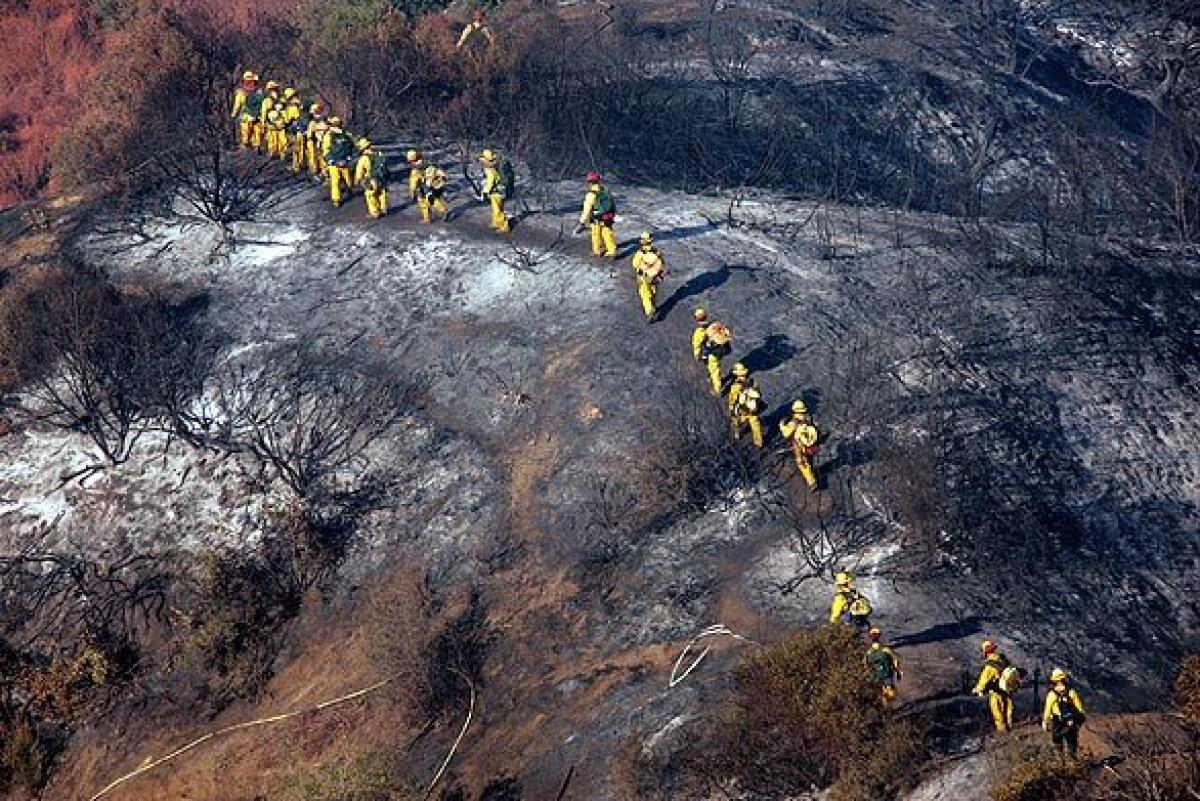Forest Service blames terrain for spread of Station Fire

- Share via
A U.S. Forest Service review of its response to the Station fire has concluded that the blaze raged out of control because it spread into terrain too steep for firefighters to safely confront the flames, but the inquiry failed to address key questions about the agency’s actions on the critical second day of the battle.
Led by Forest Service officials in Washington, D.C., the review was based largely on interviews with the commanders who directed the attack on the fire during the first two days. Its conclusions do not answer why water-dropping helicopters did not arrive in force until several hours after dawn on Day 2 and after ground crews started to fight the fire.
“The review looked at the fire through the commanders’ eyes,” said Forest Service Deputy Chief James Hubbard, leader of the inquiry. “Whether some other action could have changed things, we really didn’t look at that.”
A fire official familiar with the Day 2 operations told The Times on Friday that the crew of a state observation plane, responsible for directing the air assault, had recommended to Forest Service commanders that helicopters begin water drops early in the morning. But for reasons that remain unclear, they were not deployed.
The state Department of Forestry and Fire Protection plane was sent to the scene about 7 a.m., according to the official who spoke on condition of anonymity.
The Forest Service launched its review after The Times reported that commanders had underestimated the threat posed by the blaze during its first day and reduced the number of helicopters and crews dispatched for the next morning, Aug. 27.
In the report released Friday, the Forest Service says commanders used “best professional practices” in trying to knock down the blaze when it was still small. “Commanders were reasonable and prudent in not exposing firefighters to actions that would have been ineffective and compromised their safety,” it says.
The fire eventually killed two L.A. County firefighters, burned 250 square miles of the Angeles National Forest and destroyed about 90 dwellings.
The Forest Service had issued a memorandum three weeks before the blaze ordering managers to cut firefighting costs by minimizing their use of reinforcements from local and state agencies. Friday’s report says costs played no role in the Forest Service’s decision to use fewer reinforcements on Day 2.
The report says helicopters would have been “ineffective” earlier in the morning without ground crews at the front line, but it does not explore why more choppers were not ordered to hit the blaze as it closed in on Angeles Crest Highway, where firefighters were preparing to tackle the flames.
County Supervisor Michael Antonovich, whose district includes much of the forest area, dismissed the report as a whitewash.
“The Forest Service conclusion that aircraft use in the Station fire’s earliest stage would have been ineffective is a false assertion to justify their failure,” Antonovich said in a written statement. “Our Los Angeles County firefighting aircraft sat on the tarmac waiting to be called into action, while the Angeles National Forest burned.”
Antonovich “believes you bring everything you’ve got to fight this thing as soon as it breaks out and not wait to see what happens,” said spokesman Tony Bell.
Hubbard said the review determined that commanders did make a “just in case” request for helicopters for daybreak on Aug. 27, but the first did not arrive until about 8 a.m. He said he did not know what caused the delay.
Firefighters who were there told The Times that aerial water dumps should have begun at first light, even if ground crews could not get at the flames, and that a fiercer helicopter assault should have been unleashed once the blaze jumped the road about two hours later.
One firefighter who was part of the response on Day 2 said helicopter drops on flames in inaccessible terrain are routine, especially when the blaze is just a few acres, as the Station fire was that morning.
“If you look at history, tactics and strategies, and then look at this report, it just makes no sense,” said the firefighter, who requested anonymity because, like the official familiar with the observation-plane mission, he has been forbidden to speak publicly. “You could see early on what was going to happen with this fire.”
John Tripp, chief deputy of the county Fire Department, was among five panel members who oversaw the inquiry. He said he agreed with the conclusions that the Forest Service commanders “followed the policies and procedures appropriately,” and he suggested that the tree cover and thick brush below the highway might have made water drops less effective than they were the first day, when four county choppers unloaded on flames above the road.
But Tripp stopped short of endorsing the decision not to bring in a helicopter at first light on the second day and have more at the ready.
“It’s their fire, and they’re running it,” he said, adding that it “was not my role” in the review to second-guess the Forest Service’s decisions.
Also on the review panel was Ken Pimlott, deputy director of the state Department of Forestry and Fire Protection, who said he concurred with the findings “based on the information that was presented to me” by the Forest Service.
Pimlott said he did not interview the officers who flew the observation mission and thus could not say whether they agreed that choppers would have been ineffective during the early hours of Day 2.
Hubbard said he realized that some people might be skeptical of the inquiry because it was not done by an independent party
“But I think we were pretty thorough,” he said. “Will there be other reviews of this fire? Likely so.”
--
paul.pringle@latimes.com
More to Read
Sign up for Essential California
The most important California stories and recommendations in your inbox every morning.
You may occasionally receive promotional content from the Los Angeles Times.













